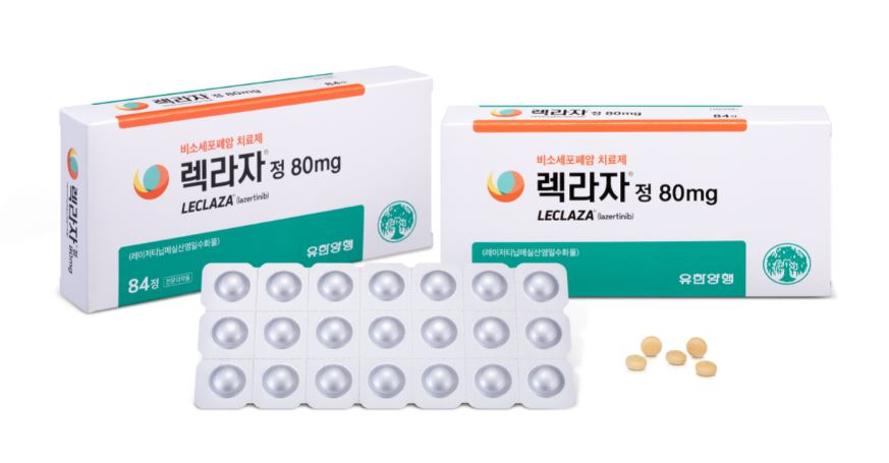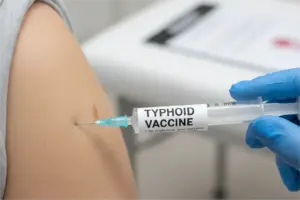2024.11.25 16:47

A study by Korean researchers has confirmed that nine weeks of upfront treatment with the new homegrown anticancer drug Lexarza can lower the stage of inoperable lung cancer patients with EGFR gene mutations detected by lung lavage fluid biopsy, making them eligible for surgery.
Konkuk University Medical Center said Monday that Professor Lee Kye-young, director of Precision Medicine Lung Cancer Center, presented the interim results of the NeoLazBAL study, a phase 2 clinical trial of the third-generation targeted anticancer drug Leclaza using lung lavage fluid biopsies, at the recent international conference of the Korean Academy of Tuberculosis and Respiratory Diseases, or KATRD 2024.
The study enrolled patients with suspected lung cancer with EGFR gene mutation DNA detected by lung lavage fluid biopsy to receive upfront treatment with Leclaza for nine weeks, followed by re-staging and surgery to confirm pathologic lung cancer diagnosis and EGFR genotype and adjuvant therapy with Leclaza for three years after surgery if the final surgical stage is stage 2 or higher or if the patient is at high risk of recurrence.
The study also evaluates the accuracy of diagnosing lung cancer by lung lavage fluid biopsy without biopsy and the sensitivity of detecting EGFR genetic mutations. In addition, the study tests whether pretreatment with Leclaza can induce downstaging and remove micrometastases, convert inoperable patients to operable patients, and ultimately reduce postoperative recurrence rates and increase lung cancer cure rates.
“We need to follow up for two to three years to see the final results in terms of recurrence rate, but we have analyzed the data to evaluate the treatment performance after completion of surgery,” Director Lee said.
In the study, 128 patients with suspected lung cancer underwent bronchoscopy and lung lavage fluid biopsy, and 48 patients with positive EGFR mutations were identified. Of these, 40 consented to participate in the study and began treatment with Leclaza, and 34 patients underwent surgical resection after nine weeks of upfront therapy.
The results showed no complete remissions, partial remissions in 55.8 percent (19 of 34), and no cases of lung cancer progression. Pathology from surgical tissue confirmed lung adenocarcinoma in all 34 patients, resolving the question of the diagnostic accuracy of lung lavage fluid biopsy in diagnosing EGFR mutation-positive NSCLC without biopsy and initiating targeted antitumor therapy.
Besides, EGFR genetic testing showed a 97.1 percent concordance of gene subtypes in 33 patients, all but one. Of the 44 patients who had a negative lavage fluid biopsy but underwent surgery for suspected early-stage lung cancer, 10 were found to be positive for the EGFR mutation, confirming the final sensitivity of lavage fluid biopsy for stage I NSCLC at 77.3 percent, including stage I.
“We compared the 34 patients whose tissues were found to be EGFR mutation-positive by lavage fluid biopsy with the 10 patients whose tissues were not,” Lee said. “As a result, we found that the sensitivity to identify EGFR mutation-positive patients using lung lavage fluid biopsy was reduced when SUBmax is low, i.e., exosome non-shedders where cancer activity index is low, in stage 1A, hepatosplenic nodules and PET-CT (positron emission tomography). However, imaging findings alone may be sufficient for surgical decision-making in these cases.”
“On the other hand, we believe that even in stage I EGFR-mutant lung cancer with a high cancer activity index (exosome shedder), surgery after upfront treatment with Leclaza may be able to induce downstaging and reduce recurrence rates,” Lee added.
Surgery was performed in the following proportions: lobectomy (90.3 percent), wedge resection (6.2 percent), and segmentectomy (3.1 percent). One patient had microscopic residual cancer cells in the resection site (R1 resection) and was treated with Leclaza to prevent recurrence after surgery, but most patients (97.5 percent) had complete resection (R0 resection).
Pathologic control outcomes included no complete palliative resections (CPRs) and a primary pathologic response (MPR) rate of 18.2 percent, which is an indicator of preoperative neoadjuvant therapy, similar to other recent neoadjuvant studies with EGFR-targeted agents.
Neoadjuvant therapy with EGFR-targeted agents has not yet become a standard of care due to recent immunochemotherapy’s lower significant pathologic response rates (50-60 percent).
“Our study showed that 55 percent of patients were induced to downstage, and the downstaging rate was close to 60-100 percent, especially for stage 1B and above,” Professor Lee said. “For example, increasing the duration of upfront treatment from nine weeks to more than six months, combining Tagrisso with chemotherapy, which is effective in stage 4, such as immunochemotherapy, or combining Rybrevant (amivantamab) and Leclaza, which is effective in stage 4, may improve the low major pathological response (MPR) rate, and it is necessary to explore the development of innovative new adjuvant therapies.”
Lee continued, “While we will need to follow up on the outcomes for recurrence in the future, the interim results of this study are very promising for patients, as they show that EGFR-mutant lung cancer patients who are expected to benefit from EGFR-targeted antitumor drugs can be successfully diagnosed without a biopsy.”
The team said that if 55 percent of patients in the study could experience a downstaging and considerably reduce recurrence rate through preoperative treatment, it would emerge as a new treatment paradigm. The research team recently received approval from the Ministry of Food and Drug Safety to recruit 20 additional patients.
In addition, lung lavage fluid biopsy has been developed as a promising early lung cancer diagnostic method that can complement the problems of tissue biopsy, which has been one of the most challenging problems in early lung cancer diagnosis, and lung adenocarcinoma with targets such as EGFR, KRAS, ALK, and ROS1, can be diagnosed by finding target genes in lung lavage fluid.
The team researches and develops early lung cancer diagnostics for untargeted lung cancer using methylated DNA, NGS (next-generation sequencing), proteomics, and exosomal small RNAs, such as miRNA or piRNA.








